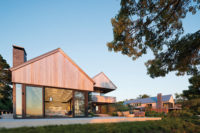The Chinese tycoon Cai Jiang has enlisted 100 of the world’s most promising emerging architects to design a villa each for his new real estate development in Inner Mongolia, in the desert near the city of Ordos, some 400 miles west of Beijing. As part of a larger effort to establish an independent urban district on the outskirts of Ordos, he also has plans to build cultural venues and administrative buildings designed by celebrated architects.
Jiang assembled an impressive group of advisors to help realize his goals. Jacques Herzog, a partner in Switzerland-based Herzog & de Meuron, consulted in the selection of the 100 young architects. Ai Wei Wei, an artist and principal of Beijing-based FAKE Design, oversaw the master plan and the project’s conceptual framework. And Xu Tiantian, of the firm DnA Beijing, designed an art museum, which opened in 2007.
The master plan sets aside 100 residential lots, each of which will accommodate an approximately 10,000 square-foot, single-family house intended for buyers with disposable income and an appetite for contemporary arts. Although Jiang has provided a specific program—including the number of bedrooms per house, Western-style kitchens, quarters for housekeepers, and indoor pools—designers are free to experiment within those guidelines.
Among the 23 American architects are WORKac, Teddy Cruz, LTL, nARCHITECTS, MOS, and Lyn Rice. Designers hailing from 26 other countries include Norway-based Jensen Skodvin; Alejandro Aravena, from Chile; Black Lines on White Paper, from Johannesburg, South Africa; and the Japanese architect Sou Fujimoto.
The so-called Ordos 100 will be executed in two stages. The first group of 28 participants traveled to the site in January, while the second group will make their way to Mongolia in early April. They will be accompanied by the first group, who will present their schematic designs and, four weeks later, complete design development drawings. Chinese architects will generate construction documents and Jiang’s organization anticipates that construction on the first houses will finish by late 2008.
New York City–based Lyn Rice, who visited the site in January, has great optimism for the project’s potential. “Before we met, there were two big fears: that this could turn into a bunch of architects trying to out-form-make the other, and that it could become a new type of gated community,” he explains. “But these are thoughtful architects who are doing thoughtful projects, and none of us wants to see competitive form-making.” And, addressing the second concern, Rice says that the architects and developers agreed to not build any perimeter barriers in order to maintain a sense of openness. “This is something that belongs very much in the realm of experiment. It’s going to be an especially interesting record of contemporary architecture.”



Post a comment to this article
Report Abusive Comment